Report: South Australian Aboriginal Diabetes Strategy Analysis, HSC203
VerifiedAdded on 2023/01/20
|7
|1789
|40
Report
AI Summary
This report analyzes the South Australian Aboriginal Diabetes Strategy, examining its establishment, core principles, and determinants of success. The strategy, developed in response to the high prevalence of diabetes within the Aboriginal community, aims to improve healthcare access and outcomes. It outlines the historical context, emphasizing the impact of socioeconomic disadvantages and poor public health on diabetes incidence. The report details the strategy's core principles, including Aboriginal health as a shared responsibility, equity in access, culturally informed healthcare, and a holistic approach. It also identifies key determinants for success, such as responsible governance, access to healthcare, well-designed control systems, and a strong workforce. By analyzing these aspects, the report highlights the strategy's comprehensive approach to addressing diabetes within the Aboriginal community and its potential for improving health and wellbeing.
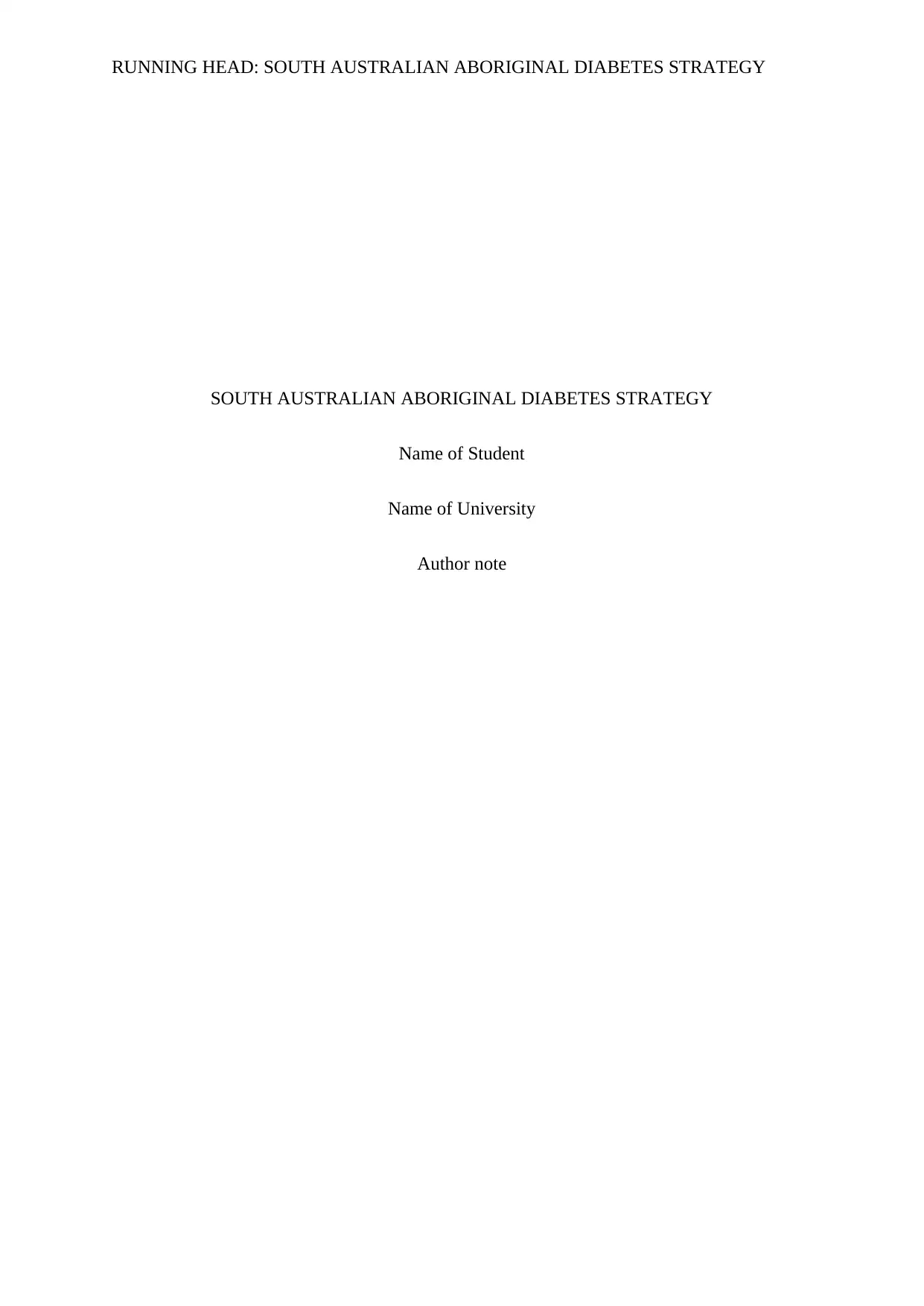
RUNNING HEAD: SOUTH AUSTRALIAN ABORIGINAL DIABETES STRATEGY
SOUTH AUSTRALIAN ABORIGINAL DIABETES STRATEGY
Name of Student
Name of University
Author note
SOUTH AUSTRALIAN ABORIGINAL DIABETES STRATEGY
Name of Student
Name of University
Author note
Paraphrase This Document
Need a fresh take? Get an instant paraphrase of this document with our AI Paraphraser
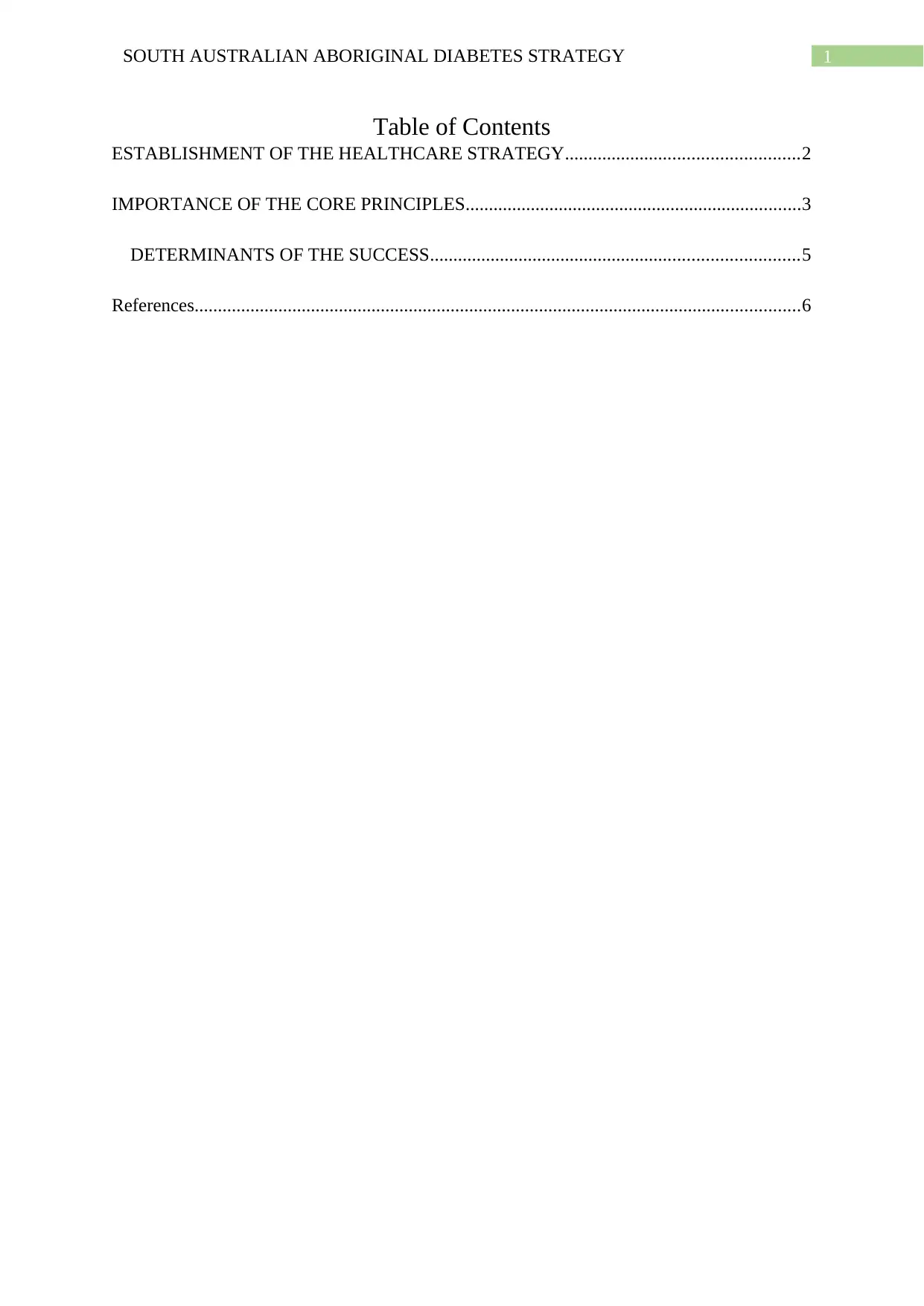
1SOUTH AUSTRALIAN ABORIGINAL DIABETES STRATEGY
Table of Contents
ESTABLISHMENT OF THE HEALTHCARE STRATEGY..................................................2
IMPORTANCE OF THE CORE PRINCIPLES........................................................................3
DETERMINANTS OF THE SUCCESS...............................................................................5
References..................................................................................................................................6
Table of Contents
ESTABLISHMENT OF THE HEALTHCARE STRATEGY..................................................2
IMPORTANCE OF THE CORE PRINCIPLES........................................................................3
DETERMINANTS OF THE SUCCESS...............................................................................5
References..................................................................................................................................6
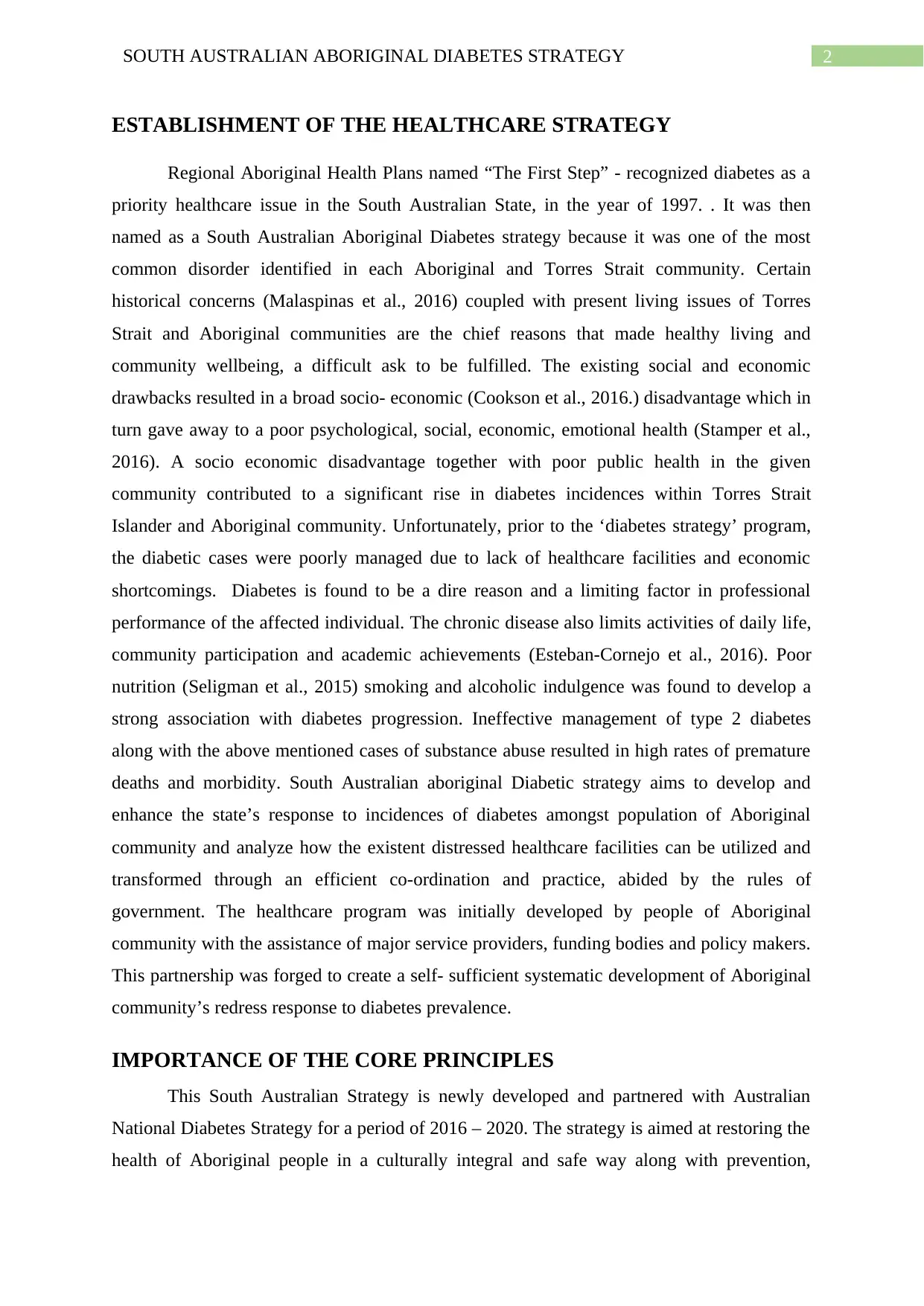
2SOUTH AUSTRALIAN ABORIGINAL DIABETES STRATEGY
ESTABLISHMENT OF THE HEALTHCARE STRATEGY
Regional Aboriginal Health Plans named “The First Step” - recognized diabetes as a
priority healthcare issue in the South Australian State, in the year of 1997. . It was then
named as a South Australian Aboriginal Diabetes strategy because it was one of the most
common disorder identified in each Aboriginal and Torres Strait community. Certain
historical concerns (Malaspinas et al., 2016) coupled with present living issues of Torres
Strait and Aboriginal communities are the chief reasons that made healthy living and
community wellbeing, a difficult ask to be fulfilled. The existing social and economic
drawbacks resulted in a broad socio- economic (Cookson et al., 2016.) disadvantage which in
turn gave away to a poor psychological, social, economic, emotional health (Stamper et al.,
2016). A socio economic disadvantage together with poor public health in the given
community contributed to a significant rise in diabetes incidences within Torres Strait
Islander and Aboriginal community. Unfortunately, prior to the ‘diabetes strategy’ program,
the diabetic cases were poorly managed due to lack of healthcare facilities and economic
shortcomings. Diabetes is found to be a dire reason and a limiting factor in professional
performance of the affected individual. The chronic disease also limits activities of daily life,
community participation and academic achievements (Esteban-Cornejo et al., 2016). Poor
nutrition (Seligman et al., 2015) smoking and alcoholic indulgence was found to develop a
strong association with diabetes progression. Ineffective management of type 2 diabetes
along with the above mentioned cases of substance abuse resulted in high rates of premature
deaths and morbidity. South Australian aboriginal Diabetic strategy aims to develop and
enhance the state’s response to incidences of diabetes amongst population of Aboriginal
community and analyze how the existent distressed healthcare facilities can be utilized and
transformed through an efficient co-ordination and practice, abided by the rules of
government. The healthcare program was initially developed by people of Aboriginal
community with the assistance of major service providers, funding bodies and policy makers.
This partnership was forged to create a self- sufficient systematic development of Aboriginal
community’s redress response to diabetes prevalence.
IMPORTANCE OF THE CORE PRINCIPLES
This South Australian Strategy is newly developed and partnered with Australian
National Diabetes Strategy for a period of 2016 – 2020. The strategy is aimed at restoring the
health of Aboriginal people in a culturally integral and safe way along with prevention,
ESTABLISHMENT OF THE HEALTHCARE STRATEGY
Regional Aboriginal Health Plans named “The First Step” - recognized diabetes as a
priority healthcare issue in the South Australian State, in the year of 1997. . It was then
named as a South Australian Aboriginal Diabetes strategy because it was one of the most
common disorder identified in each Aboriginal and Torres Strait community. Certain
historical concerns (Malaspinas et al., 2016) coupled with present living issues of Torres
Strait and Aboriginal communities are the chief reasons that made healthy living and
community wellbeing, a difficult ask to be fulfilled. The existing social and economic
drawbacks resulted in a broad socio- economic (Cookson et al., 2016.) disadvantage which in
turn gave away to a poor psychological, social, economic, emotional health (Stamper et al.,
2016). A socio economic disadvantage together with poor public health in the given
community contributed to a significant rise in diabetes incidences within Torres Strait
Islander and Aboriginal community. Unfortunately, prior to the ‘diabetes strategy’ program,
the diabetic cases were poorly managed due to lack of healthcare facilities and economic
shortcomings. Diabetes is found to be a dire reason and a limiting factor in professional
performance of the affected individual. The chronic disease also limits activities of daily life,
community participation and academic achievements (Esteban-Cornejo et al., 2016). Poor
nutrition (Seligman et al., 2015) smoking and alcoholic indulgence was found to develop a
strong association with diabetes progression. Ineffective management of type 2 diabetes
along with the above mentioned cases of substance abuse resulted in high rates of premature
deaths and morbidity. South Australian aboriginal Diabetic strategy aims to develop and
enhance the state’s response to incidences of diabetes amongst population of Aboriginal
community and analyze how the existent distressed healthcare facilities can be utilized and
transformed through an efficient co-ordination and practice, abided by the rules of
government. The healthcare program was initially developed by people of Aboriginal
community with the assistance of major service providers, funding bodies and policy makers.
This partnership was forged to create a self- sufficient systematic development of Aboriginal
community’s redress response to diabetes prevalence.
IMPORTANCE OF THE CORE PRINCIPLES
This South Australian Strategy is newly developed and partnered with Australian
National Diabetes Strategy for a period of 2016 – 2020. The strategy is aimed at restoring the
health of Aboriginal people in a culturally integral and safe way along with prevention,
⊘ This is a preview!⊘
Do you want full access?
Subscribe today to unlock all pages.

Trusted by 1+ million students worldwide
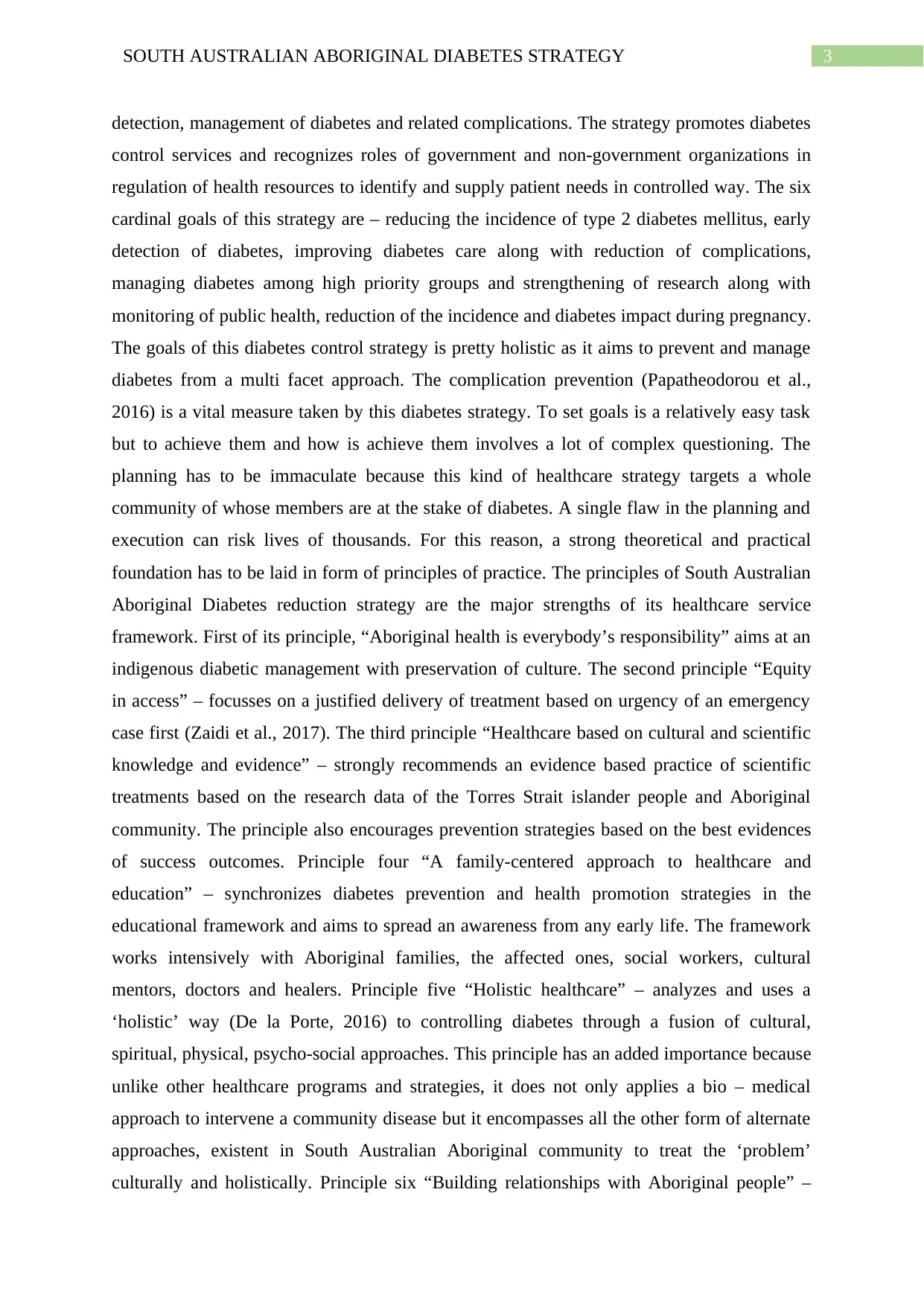
3SOUTH AUSTRALIAN ABORIGINAL DIABETES STRATEGY
detection, management of diabetes and related complications. The strategy promotes diabetes
control services and recognizes roles of government and non-government organizations in
regulation of health resources to identify and supply patient needs in controlled way. The six
cardinal goals of this strategy are – reducing the incidence of type 2 diabetes mellitus, early
detection of diabetes, improving diabetes care along with reduction of complications,
managing diabetes among high priority groups and strengthening of research along with
monitoring of public health, reduction of the incidence and diabetes impact during pregnancy.
The goals of this diabetes control strategy is pretty holistic as it aims to prevent and manage
diabetes from a multi facet approach. The complication prevention (Papatheodorou et al.,
2016) is a vital measure taken by this diabetes strategy. To set goals is a relatively easy task
but to achieve them and how is achieve them involves a lot of complex questioning. The
planning has to be immaculate because this kind of healthcare strategy targets a whole
community of whose members are at the stake of diabetes. A single flaw in the planning and
execution can risk lives of thousands. For this reason, a strong theoretical and practical
foundation has to be laid in form of principles of practice. The principles of South Australian
Aboriginal Diabetes reduction strategy are the major strengths of its healthcare service
framework. First of its principle, “Aboriginal health is everybody’s responsibility” aims at an
indigenous diabetic management with preservation of culture. The second principle “Equity
in access” – focusses on a justified delivery of treatment based on urgency of an emergency
case first (Zaidi et al., 2017). The third principle “Healthcare based on cultural and scientific
knowledge and evidence” – strongly recommends an evidence based practice of scientific
treatments based on the research data of the Torres Strait islander people and Aboriginal
community. The principle also encourages prevention strategies based on the best evidences
of success outcomes. Principle four “A family-centered approach to healthcare and
education” – synchronizes diabetes prevention and health promotion strategies in the
educational framework and aims to spread an awareness from any early life. The framework
works intensively with Aboriginal families, the affected ones, social workers, cultural
mentors, doctors and healers. Principle five “Holistic healthcare” – analyzes and uses a
‘holistic’ way (De la Porte, 2016) to controlling diabetes through a fusion of cultural,
spiritual, physical, psycho-social approaches. This principle has an added importance because
unlike other healthcare programs and strategies, it does not only applies a bio – medical
approach to intervene a community disease but it encompasses all the other form of alternate
approaches, existent in South Australian Aboriginal community to treat the ‘problem’
culturally and holistically. Principle six “Building relationships with Aboriginal people” –
detection, management of diabetes and related complications. The strategy promotes diabetes
control services and recognizes roles of government and non-government organizations in
regulation of health resources to identify and supply patient needs in controlled way. The six
cardinal goals of this strategy are – reducing the incidence of type 2 diabetes mellitus, early
detection of diabetes, improving diabetes care along with reduction of complications,
managing diabetes among high priority groups and strengthening of research along with
monitoring of public health, reduction of the incidence and diabetes impact during pregnancy.
The goals of this diabetes control strategy is pretty holistic as it aims to prevent and manage
diabetes from a multi facet approach. The complication prevention (Papatheodorou et al.,
2016) is a vital measure taken by this diabetes strategy. To set goals is a relatively easy task
but to achieve them and how is achieve them involves a lot of complex questioning. The
planning has to be immaculate because this kind of healthcare strategy targets a whole
community of whose members are at the stake of diabetes. A single flaw in the planning and
execution can risk lives of thousands. For this reason, a strong theoretical and practical
foundation has to be laid in form of principles of practice. The principles of South Australian
Aboriginal Diabetes reduction strategy are the major strengths of its healthcare service
framework. First of its principle, “Aboriginal health is everybody’s responsibility” aims at an
indigenous diabetic management with preservation of culture. The second principle “Equity
in access” – focusses on a justified delivery of treatment based on urgency of an emergency
case first (Zaidi et al., 2017). The third principle “Healthcare based on cultural and scientific
knowledge and evidence” – strongly recommends an evidence based practice of scientific
treatments based on the research data of the Torres Strait islander people and Aboriginal
community. The principle also encourages prevention strategies based on the best evidences
of success outcomes. Principle four “A family-centered approach to healthcare and
education” – synchronizes diabetes prevention and health promotion strategies in the
educational framework and aims to spread an awareness from any early life. The framework
works intensively with Aboriginal families, the affected ones, social workers, cultural
mentors, doctors and healers. Principle five “Holistic healthcare” – analyzes and uses a
‘holistic’ way (De la Porte, 2016) to controlling diabetes through a fusion of cultural,
spiritual, physical, psycho-social approaches. This principle has an added importance because
unlike other healthcare programs and strategies, it does not only applies a bio – medical
approach to intervene a community disease but it encompasses all the other form of alternate
approaches, existent in South Australian Aboriginal community to treat the ‘problem’
culturally and holistically. Principle six “Building relationships with Aboriginal people” –
Paraphrase This Document
Need a fresh take? Get an instant paraphrase of this document with our AI Paraphraser
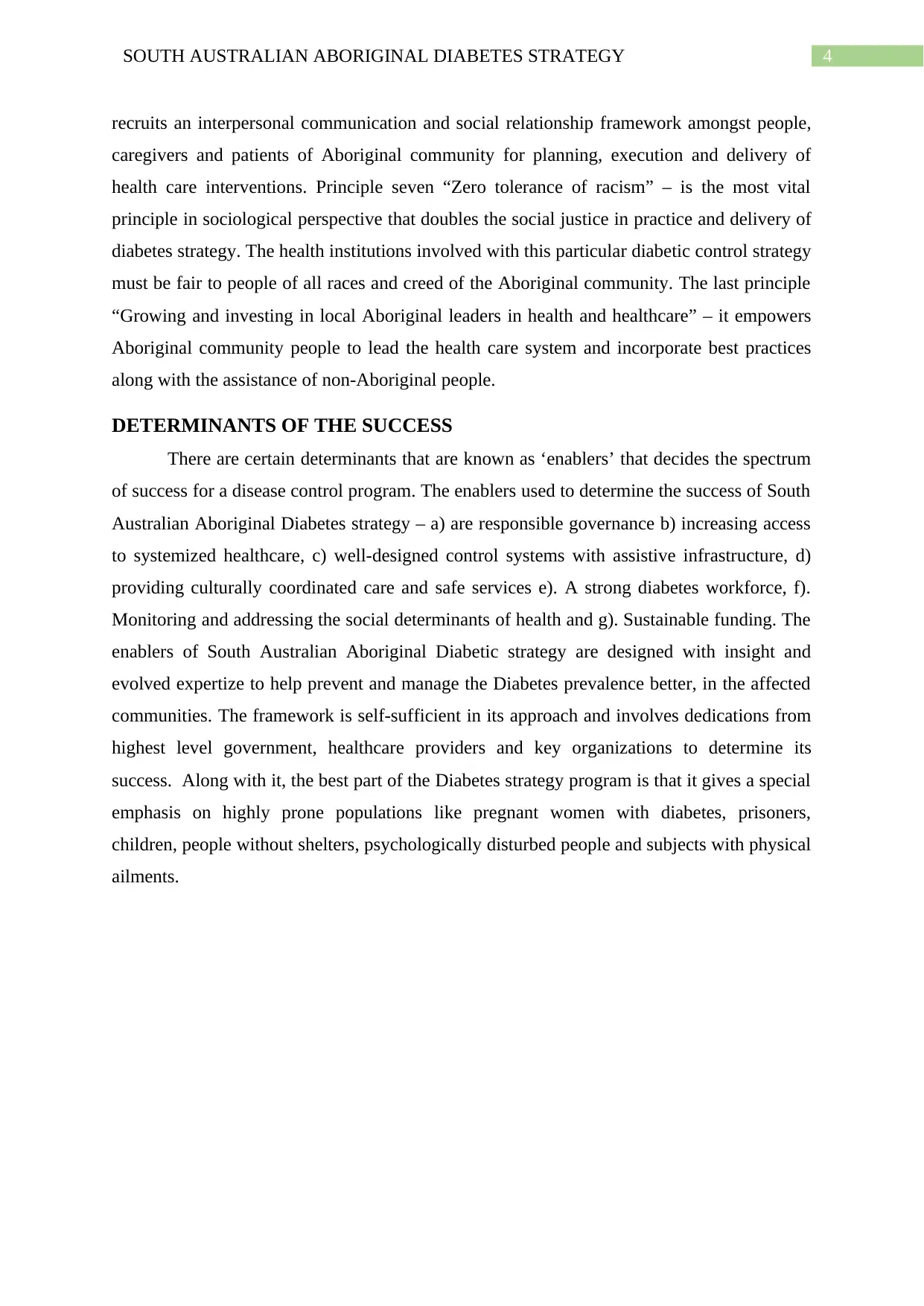
4SOUTH AUSTRALIAN ABORIGINAL DIABETES STRATEGY
recruits an interpersonal communication and social relationship framework amongst people,
caregivers and patients of Aboriginal community for planning, execution and delivery of
health care interventions. Principle seven “Zero tolerance of racism” – is the most vital
principle in sociological perspective that doubles the social justice in practice and delivery of
diabetes strategy. The health institutions involved with this particular diabetic control strategy
must be fair to people of all races and creed of the Aboriginal community. The last principle
“Growing and investing in local Aboriginal leaders in health and healthcare” – it empowers
Aboriginal community people to lead the health care system and incorporate best practices
along with the assistance of non-Aboriginal people.
DETERMINANTS OF THE SUCCESS
There are certain determinants that are known as ‘enablers’ that decides the spectrum
of success for a disease control program. The enablers used to determine the success of South
Australian Aboriginal Diabetes strategy – a) are responsible governance b) increasing access
to systemized healthcare, c) well-designed control systems with assistive infrastructure, d)
providing culturally coordinated care and safe services e). A strong diabetes workforce, f).
Monitoring and addressing the social determinants of health and g). Sustainable funding. The
enablers of South Australian Aboriginal Diabetic strategy are designed with insight and
evolved expertize to help prevent and manage the Diabetes prevalence better, in the affected
communities. The framework is self-sufficient in its approach and involves dedications from
highest level government, healthcare providers and key organizations to determine its
success. Along with it, the best part of the Diabetes strategy program is that it gives a special
emphasis on highly prone populations like pregnant women with diabetes, prisoners,
children, people without shelters, psychologically disturbed people and subjects with physical
ailments.
recruits an interpersonal communication and social relationship framework amongst people,
caregivers and patients of Aboriginal community for planning, execution and delivery of
health care interventions. Principle seven “Zero tolerance of racism” – is the most vital
principle in sociological perspective that doubles the social justice in practice and delivery of
diabetes strategy. The health institutions involved with this particular diabetic control strategy
must be fair to people of all races and creed of the Aboriginal community. The last principle
“Growing and investing in local Aboriginal leaders in health and healthcare” – it empowers
Aboriginal community people to lead the health care system and incorporate best practices
along with the assistance of non-Aboriginal people.
DETERMINANTS OF THE SUCCESS
There are certain determinants that are known as ‘enablers’ that decides the spectrum
of success for a disease control program. The enablers used to determine the success of South
Australian Aboriginal Diabetes strategy – a) are responsible governance b) increasing access
to systemized healthcare, c) well-designed control systems with assistive infrastructure, d)
providing culturally coordinated care and safe services e). A strong diabetes workforce, f).
Monitoring and addressing the social determinants of health and g). Sustainable funding. The
enablers of South Australian Aboriginal Diabetic strategy are designed with insight and
evolved expertize to help prevent and manage the Diabetes prevalence better, in the affected
communities. The framework is self-sufficient in its approach and involves dedications from
highest level government, healthcare providers and key organizations to determine its
success. Along with it, the best part of the Diabetes strategy program is that it gives a special
emphasis on highly prone populations like pregnant women with diabetes, prisoners,
children, people without shelters, psychologically disturbed people and subjects with physical
ailments.
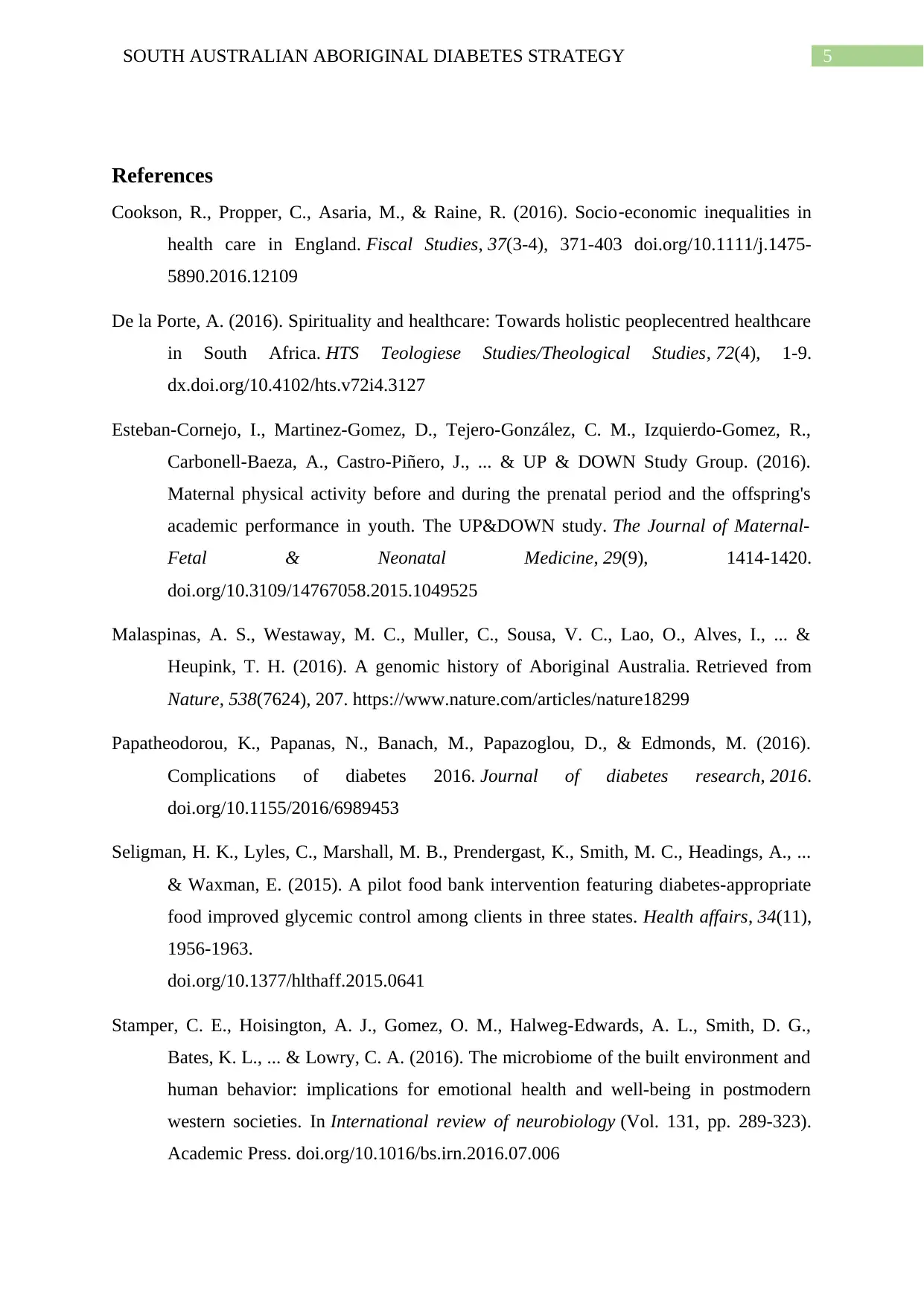
5SOUTH AUSTRALIAN ABORIGINAL DIABETES STRATEGY
References
Cookson, R., Propper, C., Asaria, M., & Raine, R. (2016). Socio‐economic inequalities in
health care in England. Fiscal Studies, 37(3-4), 371-403 doi.org/10.1111/j.1475-
5890.2016.12109
De la Porte, A. (2016). Spirituality and healthcare: Towards holistic peoplecentred healthcare
in South Africa. HTS Teologiese Studies/Theological Studies, 72(4), 1-9.
dx.doi.org/10.4102/hts.v72i4.3127
Esteban-Cornejo, I., Martinez-Gomez, D., Tejero-González, C. M., Izquierdo-Gomez, R.,
Carbonell-Baeza, A., Castro-Piñero, J., ... & UP & DOWN Study Group. (2016).
Maternal physical activity before and during the prenatal period and the offspring's
academic performance in youth. The UP&DOWN study. The Journal of Maternal-
Fetal & Neonatal Medicine, 29(9), 1414-1420.
doi.org/10.3109/14767058.2015.1049525
Malaspinas, A. S., Westaway, M. C., Muller, C., Sousa, V. C., Lao, O., Alves, I., ... &
Heupink, T. H. (2016). A genomic history of Aboriginal Australia. Retrieved from
Nature, 538(7624), 207. https://www.nature.com/articles/nature18299
Papatheodorou, K., Papanas, N., Banach, M., Papazoglou, D., & Edmonds, M. (2016).
Complications of diabetes 2016. Journal of diabetes research, 2016.
doi.org/10.1155/2016/6989453
Seligman, H. K., Lyles, C., Marshall, M. B., Prendergast, K., Smith, M. C., Headings, A., ...
& Waxman, E. (2015). A pilot food bank intervention featuring diabetes-appropriate
food improved glycemic control among clients in three states. Health affairs, 34(11),
1956-1963.
doi.org/10.1377/hlthaff.2015.0641
Stamper, C. E., Hoisington, A. J., Gomez, O. M., Halweg-Edwards, A. L., Smith, D. G.,
Bates, K. L., ... & Lowry, C. A. (2016). The microbiome of the built environment and
human behavior: implications for emotional health and well-being in postmodern
western societies. In International review of neurobiology (Vol. 131, pp. 289-323).
Academic Press. doi.org/10.1016/bs.irn.2016.07.006
References
Cookson, R., Propper, C., Asaria, M., & Raine, R. (2016). Socio‐economic inequalities in
health care in England. Fiscal Studies, 37(3-4), 371-403 doi.org/10.1111/j.1475-
5890.2016.12109
De la Porte, A. (2016). Spirituality and healthcare: Towards holistic peoplecentred healthcare
in South Africa. HTS Teologiese Studies/Theological Studies, 72(4), 1-9.
dx.doi.org/10.4102/hts.v72i4.3127
Esteban-Cornejo, I., Martinez-Gomez, D., Tejero-González, C. M., Izquierdo-Gomez, R.,
Carbonell-Baeza, A., Castro-Piñero, J., ... & UP & DOWN Study Group. (2016).
Maternal physical activity before and during the prenatal period and the offspring's
academic performance in youth. The UP&DOWN study. The Journal of Maternal-
Fetal & Neonatal Medicine, 29(9), 1414-1420.
doi.org/10.3109/14767058.2015.1049525
Malaspinas, A. S., Westaway, M. C., Muller, C., Sousa, V. C., Lao, O., Alves, I., ... &
Heupink, T. H. (2016). A genomic history of Aboriginal Australia. Retrieved from
Nature, 538(7624), 207. https://www.nature.com/articles/nature18299
Papatheodorou, K., Papanas, N., Banach, M., Papazoglou, D., & Edmonds, M. (2016).
Complications of diabetes 2016. Journal of diabetes research, 2016.
doi.org/10.1155/2016/6989453
Seligman, H. K., Lyles, C., Marshall, M. B., Prendergast, K., Smith, M. C., Headings, A., ...
& Waxman, E. (2015). A pilot food bank intervention featuring diabetes-appropriate
food improved glycemic control among clients in three states. Health affairs, 34(11),
1956-1963.
doi.org/10.1377/hlthaff.2015.0641
Stamper, C. E., Hoisington, A. J., Gomez, O. M., Halweg-Edwards, A. L., Smith, D. G.,
Bates, K. L., ... & Lowry, C. A. (2016). The microbiome of the built environment and
human behavior: implications for emotional health and well-being in postmodern
western societies. In International review of neurobiology (Vol. 131, pp. 289-323).
Academic Press. doi.org/10.1016/bs.irn.2016.07.006
⊘ This is a preview!⊘
Do you want full access?
Subscribe today to unlock all pages.

Trusted by 1+ million students worldwide
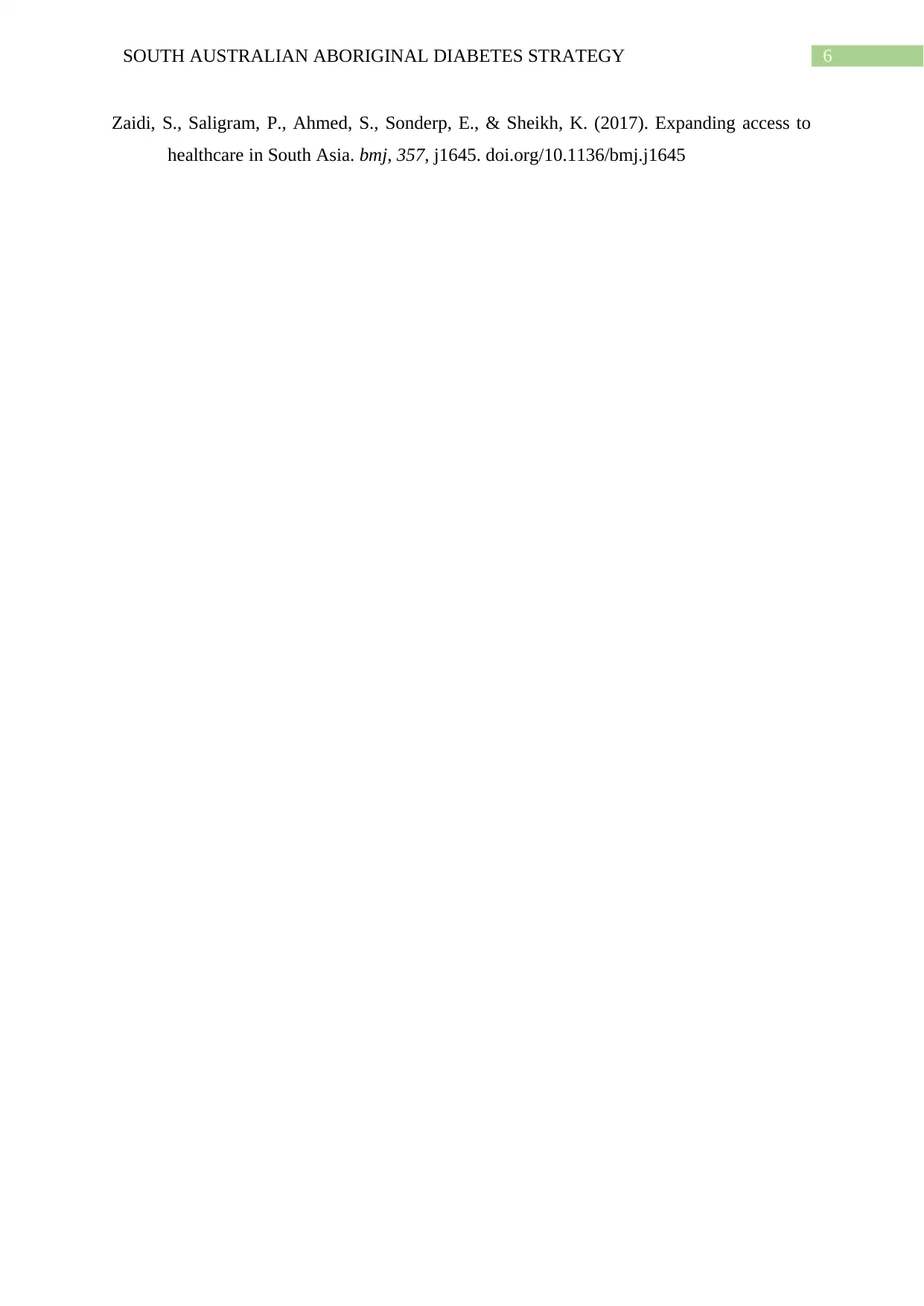
6SOUTH AUSTRALIAN ABORIGINAL DIABETES STRATEGY
Zaidi, S., Saligram, P., Ahmed, S., Sonderp, E., & Sheikh, K. (2017). Expanding access to
healthcare in South Asia. bmj, 357, j1645. doi.org/10.1136/bmj.j1645
Zaidi, S., Saligram, P., Ahmed, S., Sonderp, E., & Sheikh, K. (2017). Expanding access to
healthcare in South Asia. bmj, 357, j1645. doi.org/10.1136/bmj.j1645
1 out of 7
Related Documents
Your All-in-One AI-Powered Toolkit for Academic Success.
+13062052269
info@desklib.com
Available 24*7 on WhatsApp / Email
![[object Object]](/_next/static/media/star-bottom.7253800d.svg)
Unlock your academic potential
Copyright © 2020–2025 A2Z Services. All Rights Reserved. Developed and managed by ZUCOL.





